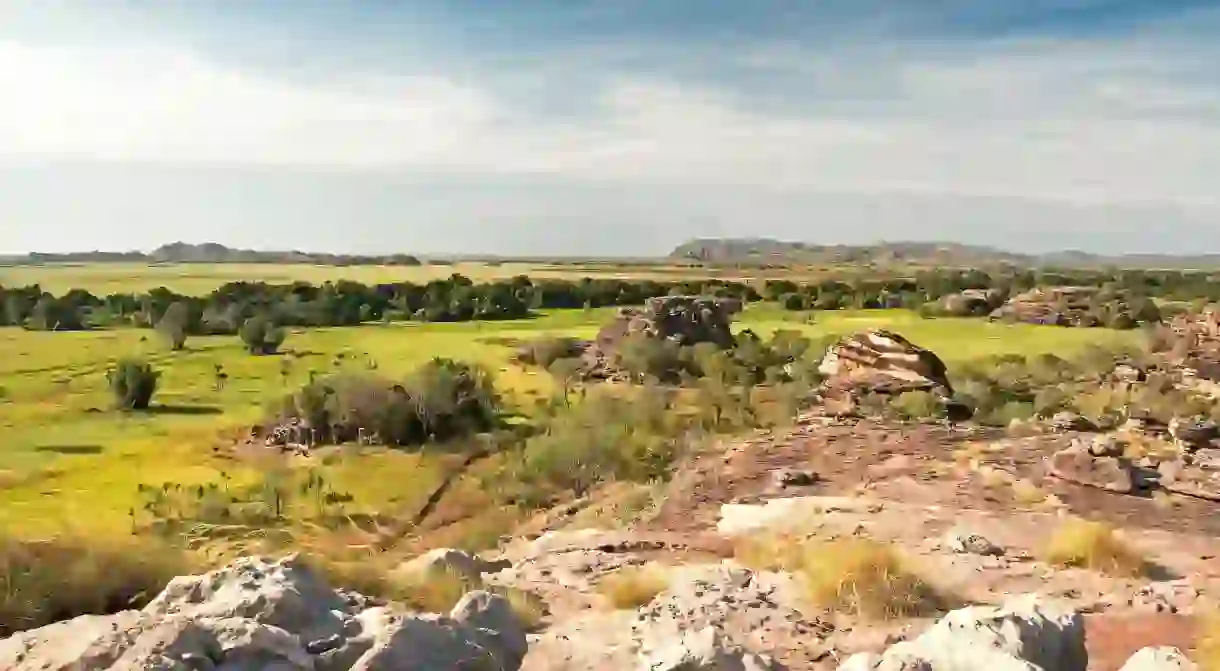A Guide to Kakadu National Park

Visit the World Heritage-listed Kakadu National Park and discover ancient Aboriginal rock art, swimming holes and waterfalls with breathtaking Outback vistas, and rugged sandstone cliffs.
Described as a unique archaeological and ethnological reserve by UNESCO, Kakadu National Park in Australia has been inhabited continuously for over 40,000 years. Keep reading to learn about the national park’s impressive ecological and biological diversity, its Aboriginal history, and the best things to do within its borders.
Facts about Kakadu National Park
Kakadu National Park is located 171 kilometres (106 miles) southeast of Darwin in Australia’s Northern Territory. It’s 19,804 square kilometres (7,646 square miles) in size, which makes it the size of Slovenia and Australia’s largest national park. It surrounds the Ranger Uranium Mine, which is one of the world’s most productive uranium mines. Kakadu National Park is home to a variety of ecosystems, such as savannah woodlands, floodplains, open forest and tidal flats. It also has 300-metre-high rugged escarpments that stretch for hundreds of kilometres.

It’s home to an abundant and diverse range of wildlife as well. This includes 60 different mammals and 117 reptile species, like wallabies, dingoes and saltwater crocodiles. There are also more than 280 different birds — or one-third of Australia’s bird species — located in the park, which makes it one of the best places in Australia for birdwatching. There’s been over 1,700 plant varieties recorded within Kakadu National Park too. A final random fact: it’s surprisingly known as one of world’s most weed-free national parks.

Located in the tropics, Kakadu National Park experiences two distinct seasons: wet and dry. Dry season (from May until September) is the best time to visit the park, as humidity is low and rain is rare. Due to the wet season’s monsoonal conditions, travel within this time can be disrupted by closed roads and dangerous swimming conditions.
Kakadu’s Aboriginal history
Aboriginal people have continuously inhabited the Kakadu region for over 40,000 years. There are more than 5,000 Aboriginal rock art sites located across Kakadu National Park that illustrate Aboriginal history over the centuries. Some sites date back an incredible 20,000 years, which makes them one of the longest historical records of any group of people in the world today. It’s this cultural significance that saw Kakadu National Park designated as a UNESCO World Heritage Site. “Kakadu rock art provides a window into human civilisation in the days before the last ice age,” UNESCO states.

The most well-known Aboriginal rock art sites are Ubirr and Nourlangie Rock (Burrunguy). There are paintings of the Rainbow Serpent at Ubirr, as well as animals like the Tasmanian tiger and catfish. There are several traditional owners of the Kakadu land from various Aboriginal groups. They jointly manage the national park alongside Parks Australia, which is a division of the Federal Government’s Department of the Environment and Water Resources.
Things to do in Kakadu National Park
Visit rock art sites
As mentioned, the rock art at Ubirr is one of the world’s best examples of traditional Aboriginal x-ray art. There’s a one-kilometre (0.6-mile) walking track to Ubirr. While visiting, climb up to Nadab Lookout for views across the floodplains, which look even more breathtaking at sunset. There’s also the 1.5-kilometre (0.9-mile) Nourlangie Rock Art Walk, which takes you past an ancient Aboriginal shelter to two main sites: the Anbangbang Gallery and Nanguluwur. To learn more about Aboriginal culture in Kakadu, visit the park’s Warradjan Aboriginal Cultural Centre.

Walk the walk
There are several walking and hiking trails to choose from within Kakadu National Park, and it will take you to rock art locations, waterfalls and wetlands.
Cruise on the billabong
Yellow Water (Ngurrungurrudjba) is a landlocked billabong, located at the end of Jim Jim Creek. It’s considered one of the best places in Australia to see native wildlife in their natural habitat. A Yellow Water Cruise is the best way to experience the billabong, where you could spot saltwater crocodiles, buffalo on the floodplain, egrets and sea eagles.

Chase waterfalls
Jim Jim and Twin Falls are known as the national park’s most breathtaking waterfalls. Jim Jim Falls is a popular swimming spot, thanks to its (literally) cool deep-plunge pools and sandy beach. To visit Twin Falls, get a boat shuttle. Tickets are available from Bowali Visitor Centre, which has displays on the wildlife, habitats and geology of Kakadu National Park as well.
Birdwatch
One of Kakadu’s best birdwatching spots, besides Yellow Water, is the observation platform at Mamukala Wetlands.

Take to the air
To see all the sights of Kakadu National Park in a limited time, consider a scenic flight. You’ll get up close to the waterfalls and witness the differing landscapes that make the national park a must-visit attraction in the Northern Territory.
Swim at Gunlom Plunge Pool
Known as one of Australia’s best swimming holes and viewpoints, the crystal-clear Gunlom Plunge Pool is located on Waterfall Creek. There’s a shaded picnic area beside the pool and a popular camping site nearby. Maguk is another lesser-known swimming hole too.














